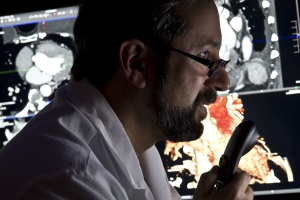by
John R. Fischer, Senior Reporter | November 22, 2021
From the November 2021 issue of HealthCare Business News magazine
With baby boomers continuing to retire throughout the next 10-15 years, by some estimates the U.S. is expected to have a shortage of more than 35,000 radiologists by 2034. The move toward retirement has only accelerated during the pandemic. For imaging professionals, these factors are contributing to a state of uncertainty regarding the future, and differing opinions on the best way to move forward.
“Some radiologists, having worked remotely from home during the pandemic, are reluctant to return to a hospital setting,” Dr. Vijay Rao, David C. Levin Professor and chair in the department of radiology at Thomas Jefferson University, told HCB News. “This, coupled with growing imaging utilization is creating a shortage of workforce. Reimbursements are also dropping and adding additional challenges in retention and recruitment of radiologists.”
The result is a supply and demand issue that often becomes a bidding war for higher salaries. Additionally, managing the resumption of delayed imaging and pressures from reimbursement cuts and calls to adopt more value-based care practices are also weighing heavily on practices and radiology departments. HCB News sat down with some insiders and experts to talk about these stresses and what approaches should be taken to address them.
Retiring now rather than later
According to the American College of Radiology, one third of full-time practicing radiologists were 55 and over in 2019 and expected to retire in the next decade. Dr. Christopher Filippi, radiologist-in-chief at Tufts Medical Center, has seen the pandemic pushing those retirement plans up. It isn’t just concerns for health and safety; some radiologists are struggling with burnout and dissatisfaction. Even before the pandemic, radiologists ranked sixth among medical specialists who were burned-out, according to Medscape’s National Physician Burnout & Suicide Report 2020.
“I think the shortage of radiologists will be exacerbated,” said Filippi. “That’s something I worry about in the back of my mind.”
Working from home has also become a preference for some over returning to work on-site, according to Rao. She says this is not completely feasible. “Radiologists are needed on-site to consult for appropriateness of imaging, supervise studies, monitor for contrast reactions and perform image-guided procedures. There is a lot of work that is done by radiologists that is patient facing. So it becomes a pressure point for us as radiologists when we don't have enough people on site.”
